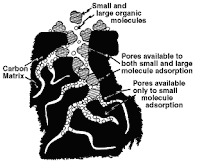The average person thinks of charcoal briquettes manufactured for use in barbe cue grills when asked if charcoal is in the home. Those briquettes have chemical additives that help them hold their shape and burn evenly. . . NOT something useful for filtration, purification or medicinal purposes!
cue grills when asked if charcoal is in the home. Those briquettes have chemical additives that help them hold their shape and burn evenly. . . NOT something useful for filtration, purification or medicinal purposes!
In contrast, Activated Charcoal is used widely in hospitals, clinics rural and urban settings. Because of it's versatility and availability, charcoal is an invaluable substance to have on hand for daily remedies and for disaster preparedness.
For more than 3,000 years Activated Charcoal has been used without adverse side effects.
of the technological advances of North America,
or hiking the trails of some developing country,
charcoal is just as modern as it was four thousand years ago,
just as universal, just as versatile, and just as powerful.
In a world being poisoned by its own near-sighted wisdom,
God the Creator has provided man with a microscopic black hole
big enough to swallow much of what ails us.
(~John Dinsley)
How is this black powder used? When taken by mouth, Activated Charcoal can keep poisons from being digested and help them pass through the body without being absorbed.
When viewed under a microscope, the surface of Activated Charcoal is seen to contain many tiny pockets. If laid out flat, the surface area of 1 teaspoon of this powder would equal that of a football field.
How to Make Charcoal
While most local pharmacies carry Activated Charcoal, it is also possible to make your own.
Click play to view video featuring Dr. Agatha Thrash speaking about recommended home remedies with activated charcoal. Learn how to make activated charcoal. Available free for personal use, recorded and distributed by owners of vegemedia.net with permission from producer 3ABN TV. 30 minutes.
You will need:
- Discarded grill lid or other heat-resistant cover
- Long-handled shovel
- Fire pit
- Cloth bag (an old pillow case will do)
- Hammer
- Old Junk Blender (one you won't be using in the kitchen again)
- Untreated hardwood, well seasoned and dry*
* Old pallets work well for this application. They are very dry and unpainted. Businesses that deal in large shipments are often glad to be rid of them.









No comments:
Post a Comment